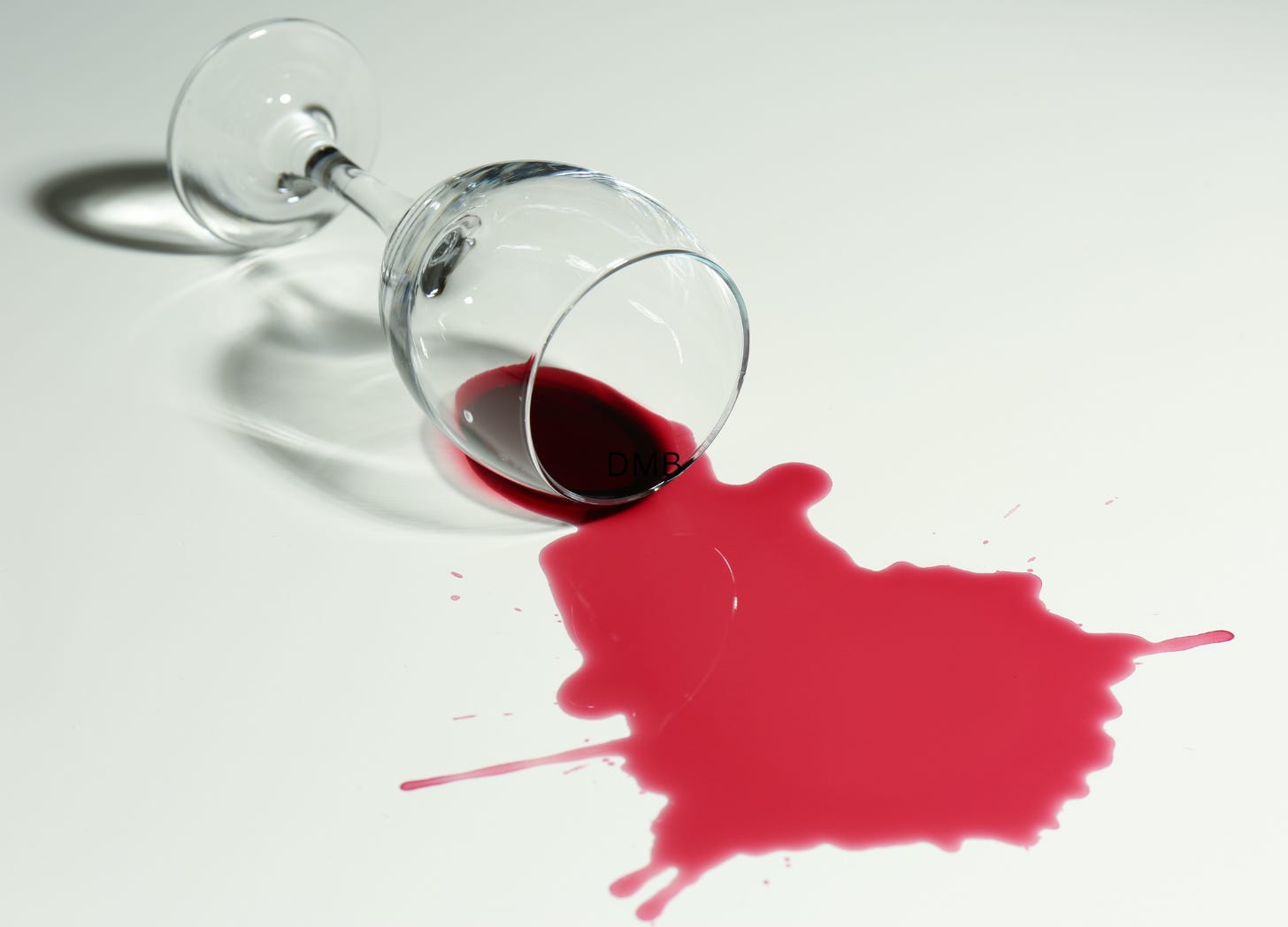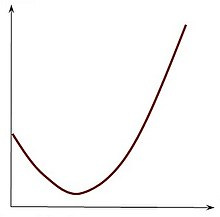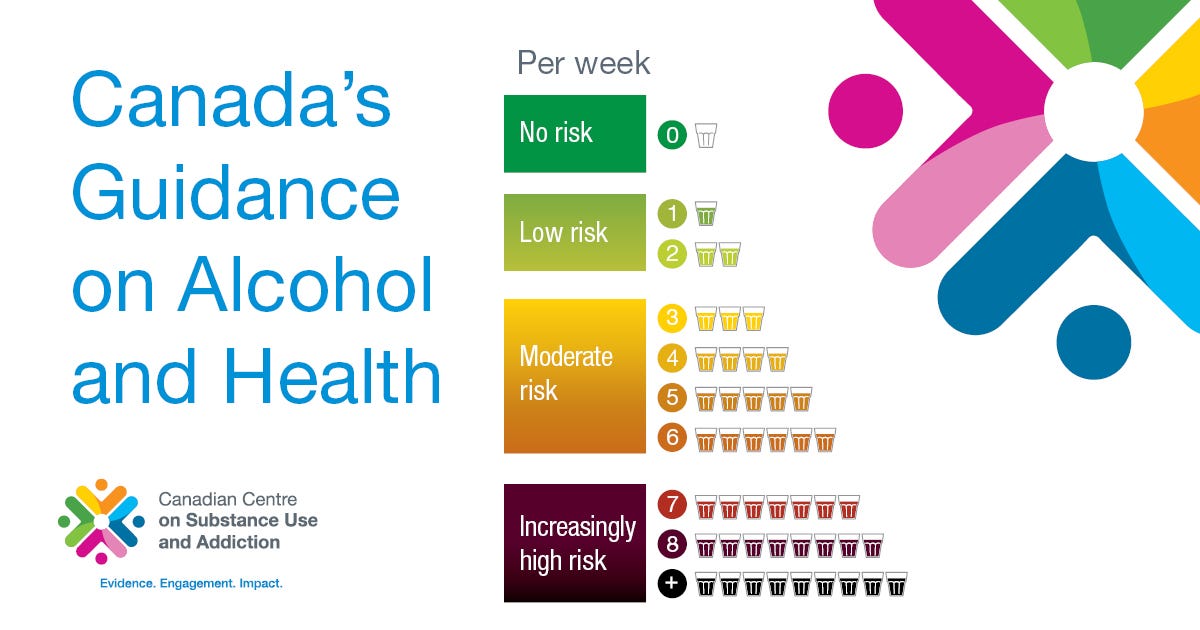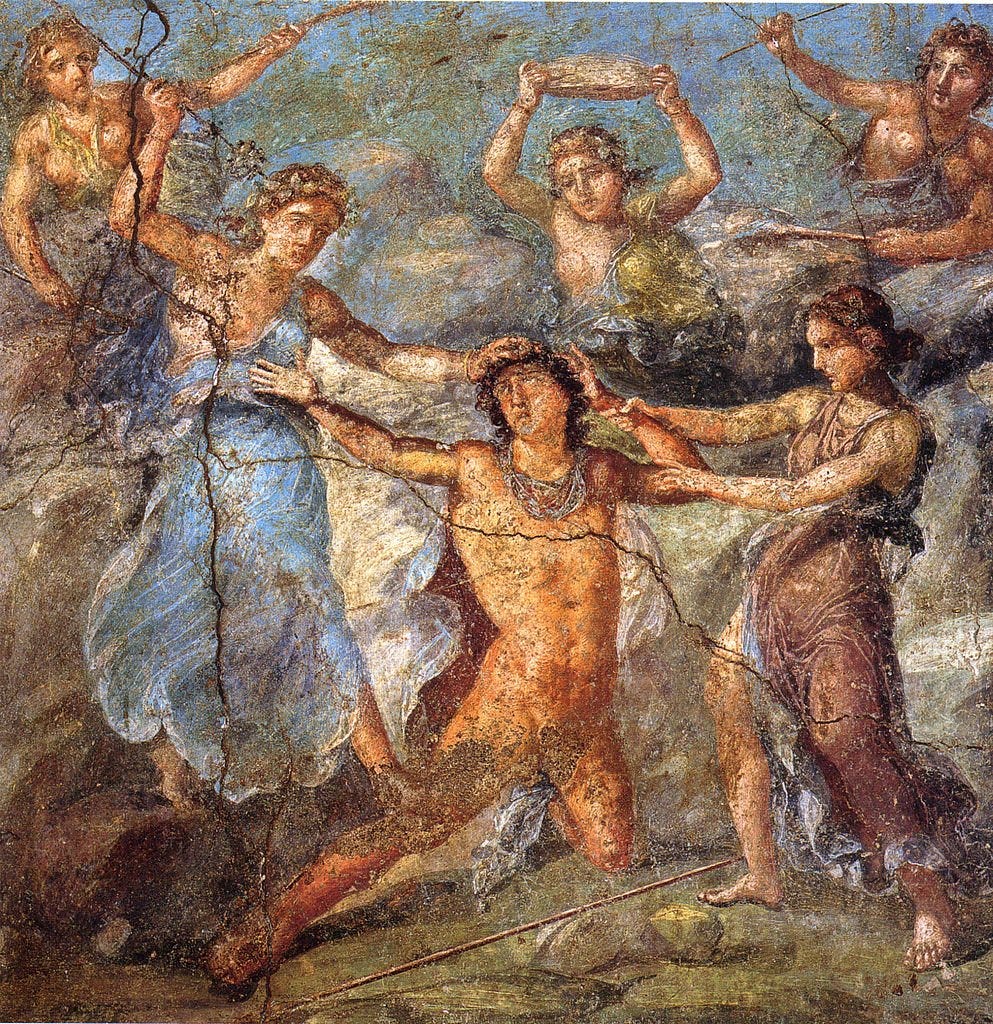The End of Wine
Wine sales are sluggish, young people are drinking less, and the specter of a "Neo-Prohibition" movement is stripping wine of its once-vaunted halo. Are we witnessing Dionysus’s last dance?
Wine is an ancient and cherished pastime for humans, woven into our mythologies and works of art—loved for its taste, history, connection to the land and, of course, its intoxicating effects. Wine has been mythologized as both an elixir of health and immortality and a muse of wild abandon and earthly delights, cutting short our mortal lives but instead offering deeply-lived experience.
These are just a few of the many myths about wine and, perhaps, hint at something we all know to be true. Biphasic by nature, wine offers us a feeling of warmth and sociability but is also a potentially dangerous substance that has been associated with numerous diseases and injuries. As French philosopher Roland Barthes wrote in his essay Milk and Wine, “Actually, like all resilient totems, wine supports a mythology which does not trouble with contradictions.”
While contradictions abound, they may soon become irrelevant if wine remains on its current trajectory, which is losing market share.
Consumption of wine world-wide has dropped nearly 3% compared to figures from 2022, which were already considered by the industry to be low.1 More recently, WSWA’s SipSource has reported that wine stocking sales have dropped 6% across retailers in the U.S. between August 2023 and August 2024.2
Health and wellness is now the siren call of younger generations3 and month-long sober holidays like Sober October have replaced youthful benders and sometimes even quiet nights with friends over a glass of wine. According to the Silicon Valley Bank 2024 State of the Wine Industry report, “The bottom line is for every consumer over 60 who stops consuming wine; they are replaced by younger consumers with a mindshare of wine half that of their elders. Time is not on our side.”4
Where does that leave an industry that’s both mythically-inclined and sometimes tragically real, valued at around $400 billion dollars? Are we facing the potential downfall of the wine industry?

The Story of Immortality
The earliest chemically authenticated wine goes back to the Southern Caucuses of modern-day Republic of Georgia nearly 8,000 years ago.5 One of the principal investigators of this discovery is biochemical archaeologist, Patrick McGovern, who wrote Uncorking the Past: The Quest for Wine, Beer, and Other Alcoholic Beverages. McGovern’s work suggests that wine was integral to various ancient cultures, with evidence also found in ancient Mesopotamia and China. His research emphasizes the cultural and social significance of wine throughout history, connecting it to rituals, celebrations, and trade. And stories.
The fermented grape has always carried a seductive lore, evolving from primitive fruit wine to drink of the elites, accompanied by tales of its miraculous powers—from the transmutation of blood to the secret of immortality. The latter myth could be said to have persisted until 2023, when it was challenged by researchers who found that there are “no significant protective associations of occasional or low-volume drinking (moderate drinking) with all-cause mortality.”6
all-cause mortality
A term that refers to death from any cause.7
This contradicted previous studies that showed a J-shaped curve indicating moderate alcohol drinkers live longer than abstainers. Researchers argued that earlier studies showing longer life for moderate drinkers were skewed by "sick quitters"—people who stopped drinking due to health issues but were still categorized as abstainers. The findings were further confounded by the fact that many moderate drinkers also follow healthier lifestyles with better diets and regular exercise.
That’s not to say wine has no benefits. Earlier research suggesting that wine provides some protection against cardiovascular disease has held up, showing a modest protective effect.8, often attributed to wine’s antioxidant properties, especially resveratrol.9 Of course, resveratrol is also present in unfermented grapes and chocolate, but wine gained the most attention—thanks in part to “The French Paradox,” a 1991 segment on the news show 60 Minutes. The segment proposed that the French, despite consuming diets rich in oil, butter, and animal fats typically linked to cardiovascular disease, enjoyed longer lives because of wine.
Wine sales in the U.S. skyrocketed, along with a persistent belief among some that red wine is healthy. This idea endured even as many of the original claims about its benefits have been challenged and proven to be more complicated than initially reported.
One major complication is the role of alcohol in cancer. Alcohol is a known class 1 carcinogen and contributes to several types of cancer, including head and neck cancer, esophageal cancer, liver cancer, breast cancer, and colorectal cancer.10 Notably, some risk for certain cancers can exist even with moderate alcohol consumption.
But cancer is not the only potential risk with alcohol. In total, alcohol use is associated with around 200 diseases and injuries.11 This is significant, to say the least. Therefore, examining all-cause mortality provides a clearer picture than isolated studies on heart disease.
On average, 255 Americans die from excessive drinking every day, shortening their lives by an average of 29 years.12 Emphasis on excessive drinking. Moderate drinking does not significantly impact all-cause mortality. However, neither does it conclusively provide protective benefits for longevity.
In other words, though wine has been around for a long time, it doesn’t mean you will be if you drink it.
The Story of Certain Death
With that said, you’re probably not going to die from drinking a moderate amount of alcohol. Public health educators have compared alcohol’s risks to those of cigarette smoking, arguing that while the dangers of tobacco are widely recognized, alcohol’s risks remain less understood. By linking the two, they hope to raise public awareness.13 However, alcohol doesn’t kill two thirds of its users like tobacco does.14
That’s not to say there’s no basis for comparison, but it does suggest that the risks of drinking alcohol may fall within what many drinkers consider an acceptable range.
Risk is the operative word here. Canada changed their guidelines for alcohol and health in 2023 focusing on “low-risk,” which is a 1 in 1,000 chance of dying a premature death. This risk exists at 2 drinks or less per week. Of course, with higher consumption comes greater risk—referred to as “dose dependency.”
dose-dependent
Refers to the effects of treatment with a drug. If the effects change when the dose of the drug is changed, the effects are said to be dose-dependent.15
Canada’s guidelines mirror the World Health Organization (WHO), which says that 2.6 million deaths worldwide are caused by alcohol.16 Unlike Canada, the WHO doesn’t create specific guidelines mediated on risk because, according to them, any alcohol is associated with some risk, such as alcohol dependence, breast cancer, or injury. Therefore, they conclude that no amount of alcohol is safe.
George Koob, the director of the National Institute on Alcohol Abuse and Alcoholism (NIAAA), has suggested that the upcoming revision of the U.S. dietary guidelines are more likely to decrease rather than increase the amount of alcohol in 2025, based on the preponderance of evidence. Currently the U.S. sets the guidelines at 2 drinks per day for those assigned male at birth and 1 drink a day for those assigned female at birth.17 This would fall within the moderate to increasingly high risk for the Canadian guidelines.
This juggling of risk has led some wine writers to argue that there’s a shadowy cabal of “Neo-Prohibitionists” highjacking science.18 Others have argued that statements like this by public officials are overreaching. Senator Ted Cruz, for instance, famously told President Biden and other Democrats to “kiss [his] ass” over the proposed changes, claiming they were trying to limit his beer consumption.
In turn, alcohol-health advocacy groups have accused "Big Alcohol" of stifling independent research.19 Unfortunately, this growing tension between alcohol health groups and pro-alcohol lobbies is also playing out in competing October social campaigns.
“Come Over October”
It’s a simple proposition: grab a bottle of wine and head to a friend’s house to share it. This campaign, emerging amid the wine industry’s concerns over new dietary guidelines and the rise of temporary abstinence trends like Dry January and Sober October, is designed to celebrate the communal and cultural aspects of wine.
Led by Karen MacNeil, author of The Wine Bible, and wine-communications executives Gino Colangelo and Kimberly Noelle Charles, the initiative emphasizes the positive side of wine beyond alcohol. MacNeil, who conceived the idea after writing a viral blog post titled “Why I Hate Dry January,” aims to highlight how wine connects deeply with nature, spirituality, and culture. She also feels that challenges like Dry January have fostered a sense of self-righteousness.
Washington Post wine columnist Dave McIntyre echoes this concern, noting a shift in public perception: “Trolls on my wine columns are regularly decrying The Post for writing about wine because alcohol is a known carcinogen. Their comments are definitely prohibitionist—alcohol is evil, not to be tolerated or encouraged.” McIntyre worries that just as temperance ushered in Prohibition, so will this new trend toward moderation.

Rachel Martin, owner of Oceano wines, said, “The Come Over October campaign, while a beautiful sentiment, may feel defensive when positioned against the well-established Sober October movement.” She suggests instead of resisting mindful drinking trends, the wine industry should demonstrate a commitment to all consumers by offering non-alcoholic options. Oceano offers wine both with and without alcohol.
MacNeil’s comments may go beyond mere defensiveness. According to Ian Blessing, former French Laundry sommelier and producer of the non-alcoholic bitters brand All the Bitter, they misrepresent a genuine need for some individuals to have alternatives and reduce or quit alcohol for health reasons.
Blessing said, “I love wine—the history, terroir, and joy it brings. So, as a recovering alcoholic who quit for my health and my kids' safety, it was disheartening to hear Karen MacNeil, whose book The Wine Bible influenced me deeply, call Dry January ‘self-righteous and puritanical.’"
Is Wine Missing the Moment?
Historian and wine writer Rod Phillips contends, “The decline of wine consumption, and alcohol consumption more generally, is not driven by announcements by the WHO or other public authorities, but by changes in everyday life in many countries.” 20 He argues that while official guidelines may influence individual choices, making a boogeyman out of “Neo-Prohibitionism” may be missing the point.
Despite the decline in volume sales, the dollar amount has actually gone up in U.S. wine sales. The U.S. wine market’s value has risen from a little over $73 billion to $107 billion at an annual average rate of 6% since 2018. Much of the decline had to do with retailers, wholesales, and consumers reducing excess inventory they overstocked post-pandemic. 21
Overall, the market is expected to normalize and revert to pre-pandemic levels with 35% of the public drinking wine, a somewhat consistent average since 2006.22 Obviously, there’s been a shift in health and wellness and wine is struggling to reach new audiences, but this is a much rosier picture than the fears expressed by some wine writers and reports.

Not to mention, despite research from the 1990s to 2000s suggesting red wine could be beneficial for your health, no more than 25% of Americans ever believed that to be true.23 And young people, though drinking less, are enjoying more white wines, sparkling wines,24 and natural wines. According to The New York Times wine writer, Eric Asimov, “My impressionistic response, bolstered by conversations with natural wine importers, retailers and restaurateurs, is that large segments of the wine market are in fact uncool. But natural wine is not one of them.”25
Perhaps wine is just not meeting the current moment? Susan DeMatei, founder of WineGlass Marketing wrote, regarding a study of 1,600 wine drinkers, “We had a hypothesis entering the study that the downturn isn’t about the product. It isn’t that people’s tastes have changed. But, the way we are presenting wine and representing wine country is not in tune with their values.”26
Low- and no-alcoholic wines offer a particularly intriguing option for those who want to reach new generations focused on health and wellness. Not only do they potentially have the protective benefits of wines with alcohol without the adverse health effects of alcohol, high-quality low- and no-alcohol wines can fetch high prices, creating greater profitability for vineyards and producers.27
The Bacchae
In The Bacchae by Euripides, King Pentheus, alarmed at the wild and ecstatic Bacchic rites, bans the worship of Dionysus. However, banning these rites does little good for the young king. Dionysus, the god of wine, is not easily thwarted.
Instead, Dionysus manipulates Pentheus and those around him, leading to a grisly demise for the king. Pentheus's own mother, in a wild frenzy fueled by ecstatic dance, divine madness, and likely more than a few glasses of wine, mistakes him for a wild animal and tears him limb from limb.
The point is there has never been only one story about wine. Wine is all of the things that wine writers have said—it’s social, communal, cultural, and ancient. It can be beautiful and even enchanting.
Wine is also alcohol. And alcohol is not just a cozy, communal drink but a drink that is correlated with injury, disease, and death no matter how charming a story we tell or how romantic its past.

These are not just stories about people who have alcohol use disorder or are habitual problem drinkers. These are stories of alcohol, even wine, leading to tragic deaths and decisions we come to regret. Alcohol is not always the cause of these problems but neither is it the sole solution to fostering relaxation and community—it is a possible feature, one that deserves a caveat and an asterisk.
The caveat is that it requires due care and the asterisk is that you don’t need it at all.
The shifting growth and reduction of wine consumption is part of the ebb and flow of generations and their priorities. If new generations choose to drink less wine, and instead enjoy other beverages, they should have our support. And so should anyone.
Of course, the same goes for drinking wine. Despite the emerging fears about the end of wine, as Ian Blessing said, “Choosing not to drink is a decision someone makes for their own well-being—no judgment is being cast. Believe it or not, most abstainers don't care what's in your glass, we just want non-alcoholic options so everyone can enjoy a great drink together.”
What’s happening and what’s next….
Join us 10/29 for a new seminar as part of my on-going No & Low series with Distill Ventures, Non-Alcoholic by the Numbers, which offers a data-driven exploration into the non-alcoholic sector with panelists include Brandy Rand (Former COO, IWSR and founder of ThirstWell), Victoria Watters (Co-Founder, Dry Atlas), and Erica Duecy (Founder, The Business of Drinks Podcast). Sign up here! 🔢
Let’s go bowling! I’ll be at the 2025 BPAA Bowling Summit talking non-alcoholic beverages and how bowling venues can have greater inclusivity while increasing their profit in my seminar “A New Way to Grow Your Bar Business” on January 20 at 11:15 - 12:30 PM. 🎳
In my latest episode of The Mindful Drinking Podcast, I got the chance to sit down with author, podcaster, and fellow Substacker, Tawny Lara, and discuss everything from mindful dating to heavy metal. 🤘🏻
Writer Alex Pellek covers the Cancer Progress Report 2024 by the American Association for Cancer Research (AACR) and looming U.S. dietary guidelines on alcohol for MedCentral, “As Alcohol Consumption Risks Rise, New Guidelines Loom.”
Thank you to Oar Health for your important work and sponsorship of Positive Damage! Learn more about how Oar Health can help you drink less or quit here.









Derek!!!! This is amazing - literally goosebumps inducing, because I’m writing a piece for this week on how we can “wine two ways” with the evolution of dealcoholzied wine. After decades in the wine industry I’m continually having conversations with beverage folks and restaurant owners about the new opportunities to meet guests where they’re at, while helping the industry we love. Absolutely going to embed and link out to your work, in my piece. Brilliant!!! 🍷💪
A respiratory infection a year ago caused me to participate in Sober October unintentionally, and gave me the opportunity to examine my habit critically. I still enjoy wine now, just once a week instead of every night.
It's wild how emotionally charged the discussion can get. On the one hand, some drinkers seem to have a deep fear they may be expected to modify their behavior. And some in the business react strongly to anything they feel might hurt sales. On the other hand, some abstainers come across as true believers, their condemnation of others' drinking perhaps fueled by past personal trauma. Getting past all this to have a productive conversation is challenging.